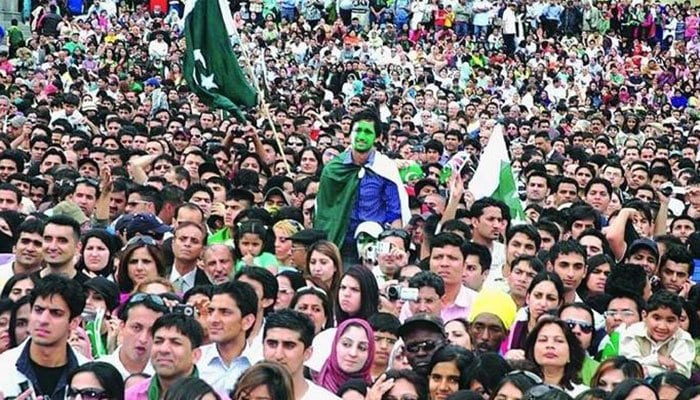The Pakistan Bureau of Statistics (PBS) has released the final results of the 6th Population and Housing Census 2017, which show that the country’s total population is 207.68 million, with a 2.4 percent annual growth rate.
There are 106.018 million men, 101.344 million females, and 321,744 transgender people in the population.
“The Council of Common Interests (CCI) on Dec 16, 2016, decided to conduct the census in two phases with the support of the armed forces. The PBS demarcated the whole country into small compact areas called census clocks comprising 200 to 250 houses on average, with a total number of over 1.68 million blocks with well-defined boundaries and maps. The entire delimitation process was carried out with the close coordination of provincial governments, local governments, revenue department, and district administrations,” the bureau states on its website.
The federal cabinet accepted the 2017 census in December last year, after a three-year break, in a meeting presided over by Prime Minister Imran Khan — with the Muttahida Qaumi Movement, one of the federal government’s allies, submitting a dissenting letter. Sindh also refused the publication of the final findings, which were accepted by the CCI last month, because it was opposed to the exercise.
Taking into account Sindh’s and other stakeholders’ concerns, the government has agreed to conduct the next census in October, utilizing cutting-edge technologies to prevent the mistakes and errors that plagued the previous exercise. It has promised to make the latest census findings public by 2023.
According to the final results of the 2017 census, the country’s annual development fell to 2.4 percent from 3.06 percent in 1981 and 2.69 percent in 1998. In 1981, 1998, and 2017, the national population was 84.25 million, 132.35 million, and 207.68 million, respectively.
The overall population counted in 2017 was 132.013 million rural and 75.670 million urban.
The population of Khyber Pakhtunkhwa increased to 30.51 million in 2017, up from 11.06 million in 1981 and 17.74 million in 1998. The population of the former Fata rose to 4.99 million inhabitants, up from 2.20 million in 1981 and 3.18 million in 1998.
Punjab, the most populous region in terms of population, had a population of 109.99 million inhabitants, up from 47.29 million in 1981 and 73.62 million in 1998. Sindh’s population grew from 19.3 million in 1981 to 30.44 million in 1998, to 47.85 million in 2017.
Balochistan’s population, on the other hand, almost tripled from 4.33 million in 1981 to 12.34 million in 1998. Similarly, the size of the Islamabad Capital Territory grew sixfold between 1981 and 1998, from 0.34 million to 2 million.
The overall population count comprises 96.47 percent Muslims, 1.27 percent Christians, 1.73 percent Hindus, 0.09 percent Ahmadis, 0.41 percent scheduled caste, and 0.02 percent others.
7.08 percent of people said Urdu as their mother tongue, followed by 38.78 percent who said Punjabi, 14.57 percent Sindhi, 18.24 percent Pashto, 3.02 percent Balochi, 0.17 percent Kashmiri, 12.19 percent Seraiki, 2.44 percent Hindko, 1.24 percent Brahvi, and 2.26 percent others.“With a -0.043pc difference with the provisional results, the country’s population, as per final results of census 2017, is 207.68m with a population growth rate of 2.40pc from 1998 to 2017 with 106.3m males and 101.3m females,” the PBS website stated.
According to the study, the 2017 census was performed in two stages, each lasting 30 days. Phase-I, which included 61 administrative districts and 79,773 blocks, started on March 15 and ended on April 14, 2017. Phase-II began ten days later, from April 25 to May 24, 2017, and included 89 administrative districts with 89,170 blocks.
According to the statistics bureau’s brief study on the 2017 census, data was collected using a “de jure method (usual place of residence),” as has been the case in previous censuses. To add legitimacy to the task, the 1998 census pattern was used, with each enumerator accompanied by a soldier. It goes on to say that one team was given two blocks in the same location.
The provincial governments had delegated 108,000 civilian field and monitoring employees, and the armed forces had supported 200,000 personnel for census duty, of which 44,000 were deployed with civilian enumerators, according to the survey. Protection, command structure, and logistic support are handled by the remaining staff.
“For a successful conduct of the census, improvement in census processes and involvement of stakeholders, the government of Pakistan constituted a sub-committee of the Governing Council of PBS consisting of renowned demographers and experts on Jan 31, 2017, with terms of reference to oversee the whole census process from training, data collection, processing, and finalization of results,” the report mentions.










